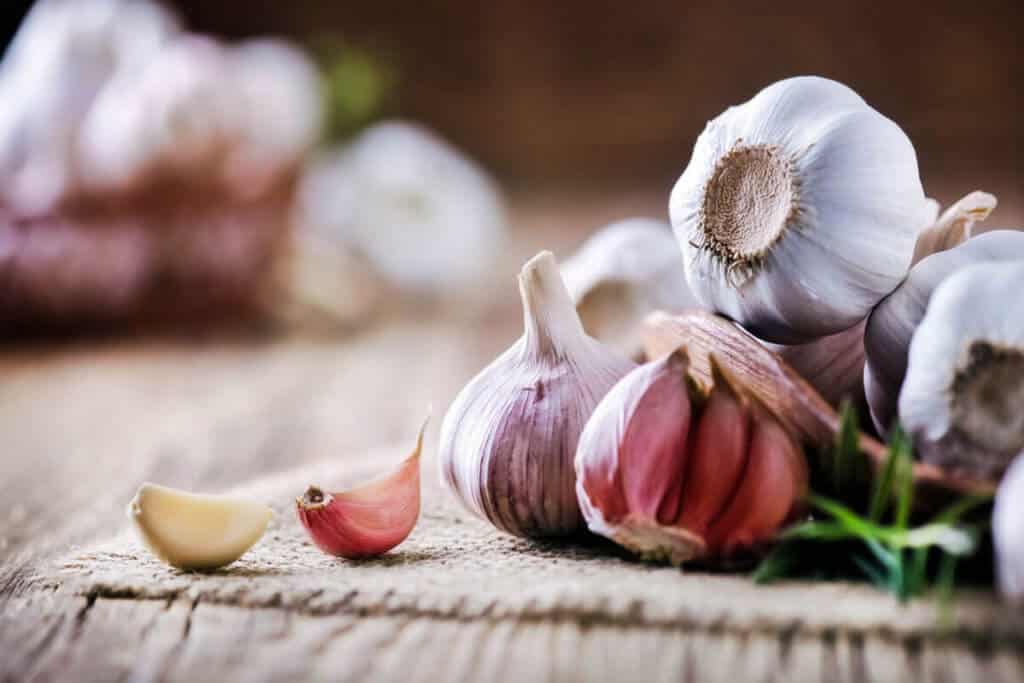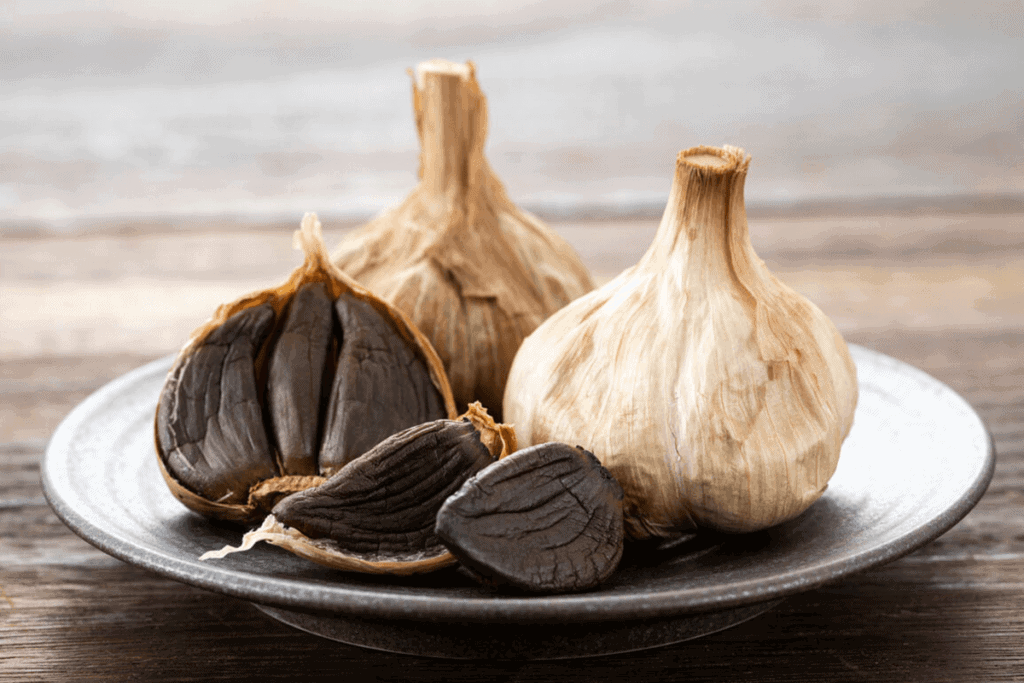Many benefits have been proposed, but what are the research-based health benefits of eating garlic? The scientific literature on garlic demonstrates various beneficial effects including antioxidant and antimicrobial activity. The herb provides protective and/or therapeutic benefits in conditions such as cardiovascular disease, diabetes, and cancer. (2) Read on to learn about garlic, types of garlic preparations, and the health benefits of the herb.
What is garlic?
Garlic (Allium sativum) is a bulbous perennial plant also known as ajo, allium, clove garlic, stinking rose, and the nectar of the gods. (1) Garlic is a member of the Lillaceae plant family, which also includes chives, onions, and shallots. (2) The plant grows in mild climates and can reach up to 3.9 feet (1.2 meters) in height. While there are several common varieties or subspecies of garlic, two of the most common include hardneck garlic and softneck garlic, referring to the sturdiness of the neck (aerial part) of the plant. (2)Garlic provides various nutrients and compounds that are responsible for its effects. Nutrients found in garlic include amino acids, fiber, calcium, iron, magnesium, selenium, zinc, and vitamins B1, A, and C. (5)

What are the types of garlic preparations?
The fresh or dried root bulb of garlic is the part of the plant typically used in herbal medicine. (11) There are several different preparations of garlic currently available as dietary supplements, including:
- Aged garlic extract (AGE), which is produced by storing sliced raw garlic in ethanol (alcohol) for 1.5 years or longer, and is proposed to increase the activity of antioxidant components including S-allylcysteine, allixin, and selenium (2)
- Garlic essential oil, which is the volatile oil containing diallyl disulfide (DADS) and diallyl trisulfide (DATS) extracted from garlic by steam distillation (7)
- Garlic oil macerate, which is produced by encapsulating a combination of whole garlic and vegetable oil, and contains compounds derived from allicin (e.g., dithiins, ajoene, sulfides) (7)
- Garlic powder, which is produced by steam distillation and contains the components diallyl, allylmethyl, and dimethyl mono to hexa sulfides (2)
How does garlic work?
As commonly seen in botanical herbs, garlic contains various components that exert beneficial health effects. Active compounds found in garlic include saponins and phenolic compounds, as well as organosulfur compounds, such as:
- Allicin (2)
- Diallyl disulfide (DADS) (1)
- Diallyl trisulfide (DATS) (1)
- E/Z-ajoene (9)
- S-allylcysteine (SAC) (1)
- S-allyl-cysteine sulfoxide (alliin) (9)
- S-allylmercaptocysteine (SAMC) (1)
When garlic is crushed or chopped, an enzyme called allinase is activated. This enzyme acts on alliin, a compound found in whole garlic, and subsequently produces allicin. The health benefits of garlic extract, including its antimicrobial effects, are largely a result of allicin. For example, allicin may protect the gastrointestinal system by inhibiting the growth of pathogens, such as Helicobacter pylori. Additionally, allicin is metabolized to a compound called ajoene, which has anticoagulant effects that may help prevent the development of atherosclerosis. (1)
Garlic also contains diallylsulfide, a component that has been shown to inhibit oxidative stress. Reducing oxidative stress may contribute to the protective effect of the herb against cancer (1) and cardiovascular disease. (9)
Garlic may exert anti-hypertensive (blood pressure lowering) activity as a result of prostaglandin-like effects, decreasing peripheral vascular resistance, which is resistance in blood vessels that contributes to high blood pressure. (2)
What are the health benefits of eating garlic?
Research has explored the medicinal uses of Allium sativum in health conditions including cardiovascular disease, diabetes, microbial infections, cancer, and other conditions. The health effects of garlic include:
- Anti-cancer
- Anti-diabetic
- Anti-hyperlipidemic
- Anti-hypertensive
- Anti-inflammatory
- Anti-microbial
- Antioxidant
- Hepatoprotective
- Immune-modulating (9)

Cardiovascular health
Garlic has been widely used in the prevention and treatment of cardiovascular conditions, such as hypertension, hypercholesterolemia, and atherosclerosis. (2) A review of randomized double-blind placebo-controlled trials found that garlic supplementation in hypertensive patients may reduce systolic blood pressure by seven to 16 mm Hg and diastolic blood pressure by five to nine mm Hg. Garlic supplementation was also found to reduce total cholesterol by 7.4 to 29.8 mg/dL. (10)In animal studies, the effects of garlic in delaying platelet aggregation (blood clotting) have been found to be comparable to aspirin. (4) However, results from a randomized controlled trial comparing the effects of garlic tablets to aspirin in healthy adults were inconclusive and the authors were unable to determine a dose of garlic that demonstrated anti-platelet activity. (8)
The cardioprotective effects of garlic may depend on the specific form supplemented. A clinical trial in individuals with high cholesterol demonstrated that 13 weeks of aged garlic supplementation reduced oxidative stress and lipid peroxidation, factors involved in elevated cholesterol and blood lipids. Interestingly, raw garlic supplementation did not show the same benefits, suggesting the higher content of phenolic and S-allylcysteine compounds in aged garlic may be essential to reducing oxidative stress. (6)
Diabetes
Garlic may reduce insulin resistance and improve blood glucose levels in individuals with diabetes. In a 12-week study of diabetic individuals, the use of garlic supplementation as an adjunct to metformin treatment, an anti-hyperglycemic medication, was associated with a greater reduction in fasting blood glucose than metformin on its own. (2) Garlic supplementation may also improve dyslipidemia (abnormal blood lipid levels) in diabetic individuals, as it was shown to reduce total cholesterol and LDL cholesterol levels, while moderately increasing HDL cholesterol levels. (2)Anti-microbial effects
Garlic has been shown to exert various anti-microbial effects, including anti-bacterial, anti-parasitic, anti-fungal, and anti-viral activity. (2) Garlic oil has been shown to disrupt Candida albicans, a type of yeast commonly associated with fungal infections, and inhibit the growth of certain bacteria, specifically Bacillus subtilis, Escherichia coli, and Staphylococcus aureus. (9) A clinical trial found that raw garlic supplementation inhibited Helicobacter pylori in individuals with H. pylori infections, (9) a condition that may contribute to the development of gastritis, peptic ulcers, and gastrointestinal cancer. Anti-viral actions of the herb include activity against viruses such as influenza A and B, herpes simplex viruses, and viral pneumonia. (2)Anti-tumor effects
Several components found in garlic may contribute to its anti-tumor effects, such as diallylsulfide, selenium, and allium derivatives. (1) Anti-tumor effects include inhibiting tumor cell growth and protecting healthy tissue against the effects of chemotherapy. A sulfur-containing compound derived from garlic known as ajoene may trigger apoptosis (cellular death) in leukemic cells, which are abnormal blood cells found in individuals with leukemia. (2) Other components of garlic were associated with the inhibition of human mammary, melanoma, and colon cancer cell growth. (2) Animal studies suggest that garlic may inhibit the development of tumors in other tissues, such as the liver, prostate, bladder, and lungs. (2)
Other conditions
Certain actions of garlic, such as its anti-oxidant effects, may help protect against neurodegenerative conditions and reduce the risk of vascular dementia and Alzheimer’s disease (AD). (7) The topical application of garlic extract may be effective in the treatment of warts and corns. (3) Additionally, garlic may regulate inflammation and benefit individuals with irritable bowel disorder (IBD) as a result of its ability to reduce proinflammatory cytokines. (1)Additional considerations
While garlic is considered to be generally safe, long-term trials may provide additional information regarding adverse effects of various garlic extracts, particularly in certain populations such as children and pregnant or breastfeeding women. (2)There have been adverse effects reported in some cases of garlic supplementation. For example, individuals may experience breath odor after consuming raw forms of garlic. Higher doses may result in nausea and vomiting. Some rare cases of anaphylaxis and burns from garlic-containing topical products have been reported. It’s important to note that garlic may be contraindicated with certain medications, such as anti-coagulant therapy. (5)
Consult with your healthcare practitioner to discuss if garlic supplementation is right for your wellness plan.
- Adaki, S., Adaki, R., Shah, K., & Karagir, A. (2014). Garlic: Review of literature. Indian Journal of Cancer, 51(4), 577.
- Bayan, L., Koulivand, P. H., & Gorji, A. (2014). Garlic: A review of potential therapeutic effects. Avicenna Journal of Phytomedicine, 4(1), 1–14.
- Dehghani, F., Merat, A., Panjehshahin, M. R., & Handjani, F. (2005). Healing effect of garlic extract on warts and corns. International Journal of Dermatology, 44(7), 612–615.
- El-Sabban, F., & Radwan, G. M. (1997). Influence of garlic compared to aspirin on induced photothrombosis in mouse pial microvessels, in vivo. Thrombosis Research, 88(2), 193–203.
- Gebreyohannes, G., & Tedla, M. (2013). Medicinal values of garlic: Review. International Journal of Medicine and Medical Sciences, 5(9), 401-408.
- Ho, X. L., Tsen, S. Y., Ng, M. Y., Lee, W. N., Low, A., & Loke, W. M. (2016). Aged garlic supplement protects against lipid peroxidation in hypercholesterolemic individuals. Journal of Medicinal Food, 19(10), 931–937.
- Mathew, B., & Biju, R. (2008). Neuroprotective effects of garlic a review. The Libyan Journal of Medicine, 3(1), 23–33.
- Shafiekhani, M., Faridi, P., Kojuri, J., & Namazi, S. (2016). Comparison of antiplatelet activity of garlic tablets with cardio-protective dose of aspirin in healthy volunteers: A randomized clinical trial. Avicenna Journal of Phytomedicine, 6(5), 550–557.
- Shang, A., Cao, S. Y., Xu, X. Y., Gan, R. Y., Tang, G. Y., Corke, H., … Li, H. B. (2019). Bioactive compounds and biological functions of garlic (Allium sativum L.). Foods, 8(7), 246.
- Varshney, R., & Budoff, M. J. (2016). Garlic and heart disease. The Journal of Nutrition, 146(2).
- World Health Organization. (1999). Bulbus Allii Sativi. In WHO Monographs on Selected Medicinal Plants (Vol. 1). Retrieved from https://apps.who.int/medicinedocs/en/d/Js2200e/4.html





